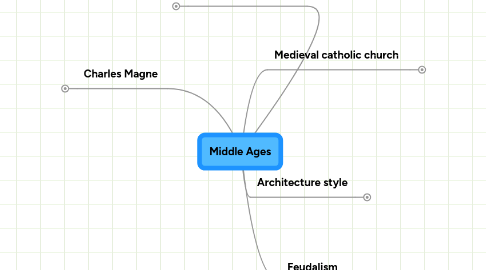
1. Charles Magne
1.1. Charlemagne, also known as Charles the Great or Charles I, was the king of Franks. He united most of Western Europe during the early Middle Ages and laid the foundations for modern France and Germany.
2. Middle Ages periods
2.1. Early Middle Ages 500 - 1000
2.1.1. The fall of western Roman Empire
2.1.2. Charlemagne, the Emperor of romans
2.2. High Middle Ages 1000 - 1250
2.2.1. Battle of Hastings
2.2.2. Declaration of Magna Carta
2.2.2.1. The Magna Carta Libertatum, was originally issued in 1215. This charter is considered to be the first step towards the constitutional government of England. The Charter of Magna Carta restricted the power of the Emperor and proved the importance of a Constitution.
2.3. Late Middle Ages 1250 - 1500
2.3.1. Great Famine of 1315 - 17
2.3.2. Hundred Years' war
2.3.3. The Black Death
3. Medieval catholic church
3.1. Power of Medieval Church
3.1.1. The control the Church had over the people was total
3.1.2. The Church did not have to pay taxes
3.1.3. Important cities would have cathedrals in them
3.2. Monk's day
3.2.1. 2.00am - 'Matins' Church Service, then back to Bed •4.00am - 'Lauds' Church Service, then back to Bed •6.00am - 'Prime' Church Service •6:30am - Breakfast while servants have church service •7.00am - Wash followed by Reading •9.00am - 'Terce' Church Service •10.00am - 'Chapter' Meeting •10.30am - Conversation followed by Work •11.00am - High Mass Church Service •12.00pm - 'Sext' Church Service •1.00pm - Hand washing followed by Lunch •1.30pm - Rest •2.00pm - Work •3.00pm - 'Nones' Church Service •4.00pm - Work •5.00pm - 'Vespers' Church Service •6.00pm - Dinner •6.30pm - Walking or Reading •8.00pm - 'Compline' Church Service •9.00pm - Bedtime
4. Architecture style
4.1. During middle Ages religious architecture was very important. In ecclesiastical architectures the Latin cross plan was very common, like a Roman basilica.
4.2. Military structures were important too. It was very important to have castles or fortified walls.
5. Feudalism
5.1. King
5.2. Lords
5.2.1. (vassals to King)
5.3. Knights
5.3.1. (vassals to Lords)
5.4. Paesants
5.4.1. (serfs)
